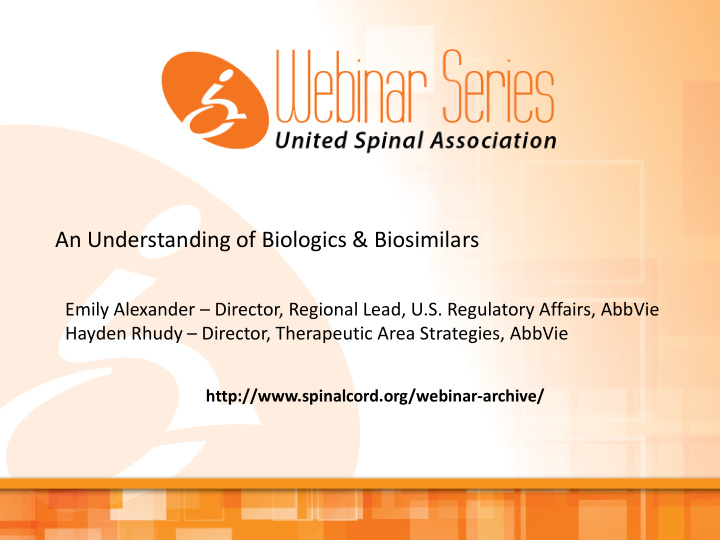



An Understanding of Biologics & Biosimilars Emily Alexander – Director, Regional Lead, U.S. Regulatory Affairs, AbbVie Hayden Rhudy – Director, Therapeutic Area Strategies, AbbVie http://www.spinalcord.org/webinar-archive/
QUESTIONS? To ask a question or make a comment, please type it in the “Questions” box on the right of your screen
Agenda Overview of Biologics Introduction to Biosimilars Open Policy Questions Related to Biosimilars Q&A 3
Biologics Are Far More Complex Than Conventional Medicines Conventional drugs (small-molecule, Biologics (large molecule medicines) chemically synthesized medicines) Monoclonal Antibody Aspirin 180 Daltons and Zero Amino Acids 148,000 Daltons and 1,330 Amino Acids Small, simple molecules Often tablets or creams Large, complex molecules Often injected or infused Made through simple chemical reactions Grown in living organisms 4
Examples of Biologics Vaccines • Human growth hormones • Interferons • Thrombolytics (Clot Busters ) • Insulins • Botulinum toxins • Monoclonal antibodies • And many more! • – Biologics treat a wide array of conditions, including cancer, multiple sclerosis, rheumatoid arthritis, ulcerative colitis, diabetes, spasticity, psoriasis, cystic fibrosis, respiratory virus – Hundreds of biologics are in development to treat areas of unmet medical needs, including Alzheimer’s disease 5
How are biologics different from small molecules? 6
Generic Copy of Small-Molecule Medicine: SAMENESS Small molecule medicines have Identical copy can be simple structures and made by unrelated Generic will have Automatic are made through manufacturers (i.e., a identical clinical substitution at generic copy); relatively simple effect in any pharmacy results manufacturing approved on basis of indication (or disease) processes (that aren’t sameness sensitive to changes) 7
Biosimilar Copy of Biologic: SIMILARITY Biologics have large, Automatic complex structures Only a “similar’ May have small substitution is not and are made version can be differences in clinical typically allowed for through complex created; impossible effect; approval of all biologics; requires a manufacturing for an identical copy indications is not higher standard of processes (that are to be made automatic evidence in the very sensitive to small United States changes) 8
U.S. Biosimilar Regulation Generics have been on the market in the U.S. for many decades; • most policy decisions are relatively settled Policymakers recognized the need for a separate pathway for • biosimilars from generics because of the different policy questions posed by a product that is similar but not the same FDA did not have authority to approve biosimilars until March • 2010, when Congress enacted the Biologics Price Competition and Innovation Act To date, no biosimilars have been approved (but several • applications are pending) This new type of product and new approval standard (similarity) • raises many new policy questions that will impact patients, regulators, physicians, pharmacists, and many others! 9
Important Policy Issues for Individuals living with Spinal Cord Injuries/Disorders Interchangeability: This year, the FDA will be deciding what standards must be met for a biosimilar medicine to be determined “interchangeable” with the original biologic medicine. Rigorous Testing for Each Condition: The FDA will be determining whether drug companies must conduct rigorous clinical testing to prove that a biosimilar works in each and every condition Naming: The FDA will decide whether biosimilars will have the same name as their reference product. Substitution/Notification: State legislation has been proposed to regulate the substitution of biosimilars with the reference product. 10
Call to Action Request to Congress: • Please hold oversight hearings on this important process and urge the FDA to release clear guidance as soon as possible that ensure patient safety, patient access to the right biologic medicines, patient choice and full transparency. • Choice should be at the center of any decision to substitute or switch therapies and should only be decided by the consumer and provider. Consumer choice needs to be preserved and regulatory decisions must be based on sound science. • Biosimilar regulations must put consumer safety first. Policymakers and regulators must address appropriate consumer safety and efficacy concerns as they relate to decisions around interchangeability, clinical indications, labeling, naming and substitution. • Particular attention must be given to assure that rigorous clinical testing proves that a biosimilar works safely in each and every condition or disease for which it is approved to be prescribed, as well as in each distinct group of individuals with that disease. • Ensure pharmacists maintain records of substitutions for significant periods of time would allow the medical community to track long-term treatment outcomes of biosimilars.
Roll on Capitol Hill, 2015 June 7-10, 2015 / Over 100 advocates participate from across the country for over 200 scheduled meetings with Members of Congress and Congressional staffers to advocate on healthcare, transportation, and disability rights issues that impact access, mobility and independence of all those impacted by spinal cord injuries and disorders. Sunday June 7: Arrival and Welcome Reception • Monday June 8: Education Sessions, Speaker Panels and Presentations, Advocacy Training • Tuesday June 9: Capitol Hill Meetings followed by Congressional Awards Reception • Wednesday June 10: Advocate Recognition Breakfast • http://www.unitedspinal.org/events/roll-on-capitol-hill
THANK YOU QUESTIONS? To ask a question or make a comment, please type it in the “Questions” box on the right of your screen abennewith@unitedspinal.org
Recommend
More recommend